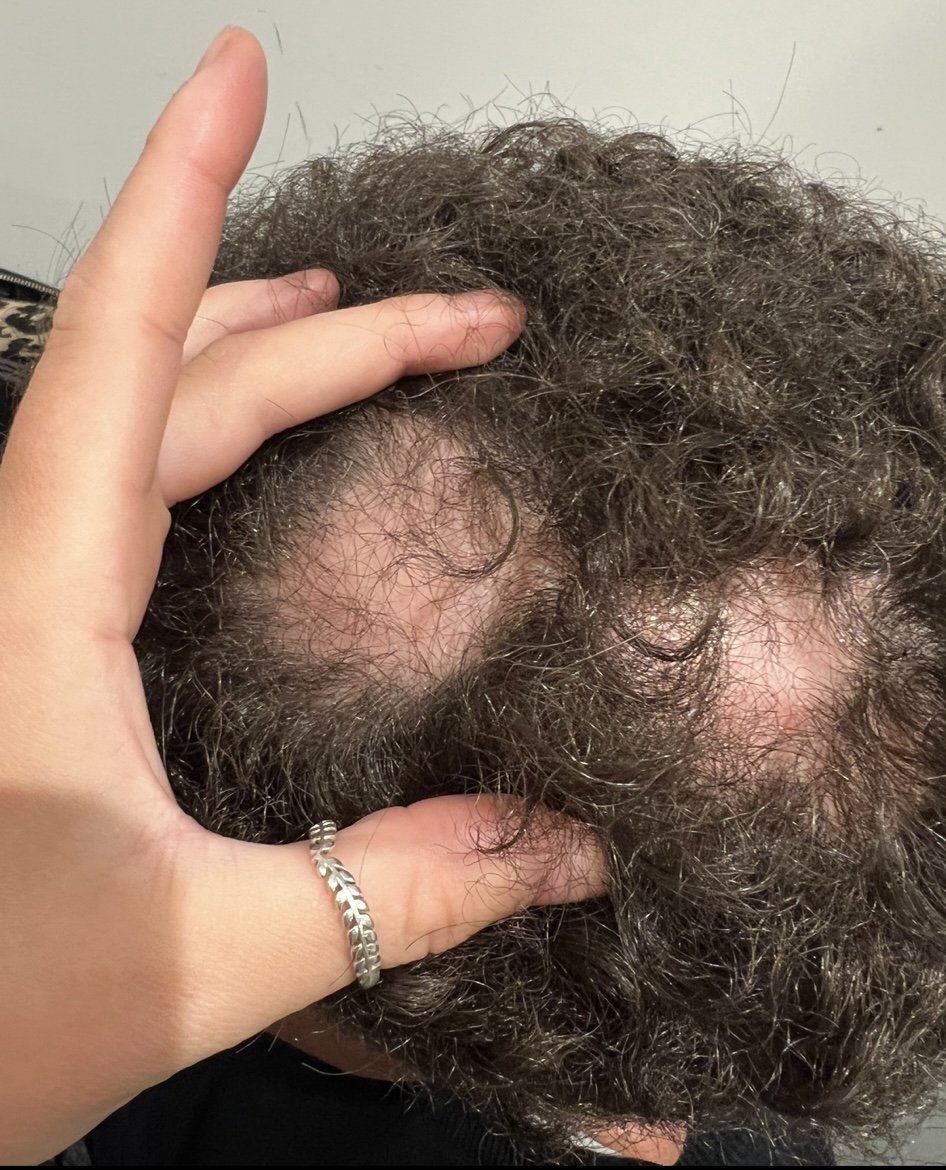Alopecia
Androgenetic Alopecia (Pattern Hair Loss)
What is Androgenetic Alopecia?
Hairs on the scalp grow in tufts, usually of 3-4 hairs. In Androgenetic Alopecia, the hair tufts on the gradually shrink, so the number of hairs in each tuft decrease (this is called ‘miniaturisation’). Eventually, when all the hairs in the tuft are gone, the skin of the scalp appears between the hairs. Androgenetic Alopecia is often referred to as 'Male Pattern Hair Loss' or 'Female Pattern Hair Loss'. It is the most common type of hair loss, affecting approximately 50% of men over the age of 50 and around 50% of women over the age of 65. Androgenetic Alopecia can also affect younger men and women.
What does Androgenetic Alopecia look like?
Androgenetic Alopecia tends to look different between males and females. In men, the typical pattern of hair loss is a receding hair line with loss of hair from the top and front of the head, often in a classic M-shaped pattern. In women, the usual pattern of hair loss is thinning at the crown of the head, with the frontal hairline over the forehead remaining. It is less likely that a woman will experience total baldness as a result of Androgenetic Alopecia.
How is Androgenetic Alopecia diagnosed?
Your doctor will usually diagnose Androgenetic Alopecia by examining the pattern of hair loss on the scalp. They may also perform blood tests to measure hormone levels, serum ferritin and thyroid function.
Is Androgenetic Alopecia permanent?
The hair follicles affected by Androgenetic Alopecia are permanently damaged. There are treatments which can help to delay the process, but hairs that have been lost will not grow back.
What causes Androgenetic Alopecia?
Androgenetic Alopecia is caused by both genetic and hormonal factors, many of which are not yet understood. This form of hair loss is related to hormones called androgens, particularly an androgen called dihydrotestosterone (DHT). Increased levels of androgens such as DHT in hair follicles can lead to a shorter cycle of hair growth and the growth of shorter and thinner strands of hair. Follicles can also stay in the resting phase for longer periods of time.
Although researchers suspect that several genes play a role in Androgenetic Alopecia, however, to date, only changes in one gene, the androgen receptor gene, have been linked to development of Androgenetic Alopecia. Androgen receptors allow the body to respond appropriately to dihydrotestosterone and other androgens. Studies suggest that changes in the androgen receptor gene lead to more active androgen receptors in hair follicles. It remains unclear, however, how these genetic changes increase the risk of hair loss in men and women with Androgenetic Alopecia.
Can Androgenetic Alopecia be treated?
As with other types of alopecia, there is no cure for Androgenetic Alopecia. However, the effects of Androgenetic Alopecia may be slowed down with treatments. For men, potential treatments include oral finasteride and/or topical minoxidil solution or foam, and for women topical minoxidil solution or foam. Hair transplantation can be used to improve the appearance of Androgenetic Alopecia .
Is Androgenetic Alopecia inherited?
It is difficult to say whether Androgenetic Alopecia is inherited or not, because there are many genetic and environmental factors likely to be involved. However, this condition does tend to cluster in families and having a close relative with patterned hair loss appears to be a risk factor for developing the condition.
Alopecia Areata
What is Alopecia Areata?
Alopecia Areata is thought to be an autoimmune condition, which often starts with isolated patches of hair loss, commonly in one or more coin-sized (usually round or oval) patches on the scalp and/or across the body including the beard, eyebrows, eyelashes or body hair, including pubic hair.
In Alopecia Areata, cells from the immune system (a specific type of T cell, known as NKG2D+ T cells) gather around the hair follicles. These cells attack the follicle, stopping it from producing more hair. The exact way in which this happens is not yet understood.
Are there different types of Alopecia Areata?
Alopecia areata can take several different forms:
Alopecia Areata (patchy hair loss)
Alopecia Areata shows up as round or oval patches on the scalp or other places on the body that grow hair. This type of Alopecia Areata can sometimes develop into either Alopecia Totalis (hair loss across the entire scalp) or Alopecia Universalis (hair loss across the entire body), but in most cases it remains patchy and eventually regrowth occurs. For some people with Alopecia Areata the patchy hair loss continues over a long period of time, without ever developing into Alopecia Totalis or Alopecia Universalis: this is sometimes referred to as ‘Persistent Patchy Alopecia Areata’ or ‘Chronic Alopecia Areata’.
How is Alopecia Areata diagnosed?
Alopecia Areata is diagnosed by your doctor. Sometimes, extra tests are needed to confirm the diagnosis. These can include trichoscopy (an examination of the hair and scalp under a microscope) or a skin biopsy.
How long will Alopecia Areata last?
Alopecia Areata does not cause permanent hair loss. The hair follicles are not destroyed, and hair does have the possibility to re-grow. Usually, in Patchy Alopecia Areata, hair will regrow over a period of months or years, but regrowth cannot be guaranteed. Many people with Alopecia Areata do experience full regrowth. However once the condition has developed to Alopecia Totalis or Alopecia Universalis, the chances of full regrowth become smaller. It is quite common for people with Alopecia Areata to experience hair loss on and off throughout their lives.
Is there a cure for Alopecia Areata?
There is currently no cure for Alopecia Areata, however, there are a variety of treatments on offer: unfortunately, none are guaranteed to work. Many people experience spontaneous regrowth without treatment. Treatments are more likely to be effective in milder cases of Alopecia Areata, with small patches of hair loss.
Common treatments for Alopecia Areata include corticosteroids (designed to dampen down the immune response), topical immunotherapy (to distract the immune response). New therapies on the horizon include JAK-inhibitors, which suppress specific parts of the immune system.
Is Alopecia Areata inherited?
In about 20% of cases, Alopecia Areata is inherited. Alopecia areata is a 'polygenic condition', so there are several genes involved. As well as a specific set of genes, your environment also contributes to developing Alopecia Areata. Most children with Alopecia Areata do not have a parent with the disease, so most people with the condition do not pass it down to their children.


